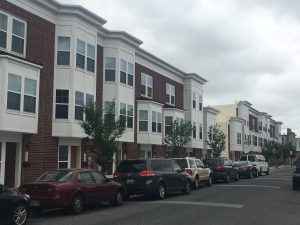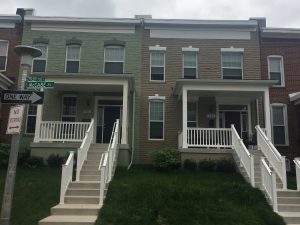A New Canvas for Baltimore: Habitat for Humanity of the Chesapeake Works to Help Revitalize and Stabilize Baltimore City
With the receipt of Project C.O.R.E. funding, Habitat for Humanity of the Chesapeake will soon bring new and renovated homes to market. The nonprofit is working on ten homes in Sandtown-Winchester, making way for new homes along Ward Street in Washington Village, and stabilizing ten properties on McCabe Avenue, while also converting three empty lots into open green space in Woodbourne McCabe.
During the FY16 round, the nonprofit received $310,000 of the total $1.5 million needed for its Sandtown Stabilization Project, $150,000 of $1.7 million for the Ward Street project, and $125,000 of $527,853 for its work in Woodbourne McCabe. These projects are located in some of the areas in the city most in need of revitalization, and keep in practice with Habitat of the Chesapeake’s existing work in these neighborhoods.
For the last decade, Habitat of the Chesapeake has regularly utilized department funds through the Community Development Block Grant, Maryland Affordable Housing Trust, Self-Help Homeownership Opportunities, and New Market Tax Credits initiatives. They have raised more than $1 million in donations by leveraging Community Investment Tax Credits.
Stabilizing Sandtown-Winchester
In Sandtown-Winchester, where the 2015 civil unrest originated, Habitat staff and volunteers will work to rehabilitate 10 homes located along Gilmor Street, Presbury Street, Presstman Street, Fulton Avenue, and Mount Street with the long-term goal of ultimately putting these homes back on the market for low-income families. All the homes are located within blocks of each other in Baltimore’s Sandtown-Winchester neighborhood.
Sandtown-Winchester has long been a focal point for Habitat of the Humanity. Until 2014, when it merged with Habitat of the Chesapeake, the organization had a chapter specifically for this neighborhood. Since 1989, the group has built more than 300 homes within 15 blocks; 25 of those were constructed within the last five years.
Ward Street Demolition
Washington Village, a Baltimore City neighborhood that residents also lovingly refer to by its old moniker of Pigtown, is one of the most historic areas the city has to offer. Pigtown dates back to the 1840s and was originally called home by many employees of the B&O Railroad. It got its name from its status as a destination for pigs unloading from the trains that were to be herded through the city. Despite its rich history, many homes in the neighborhood have fallen into disrepair over time: one in eight properties in this 2,740 home neighborhood is abandoned.
Habitat first began working with this neighborhood back in 2003, and since then they have rehabilitated 35 homes there. Many of these homes are along Ward Street, where much of the work for this round will be focused as well. The properties selected will be demolished. This, in turn, will help the group make way for seven new homes that will be available to low-income families. It will also help to increase property values in Pigtown and help this historic and colorful neighborhood bounce back.
Woodbourne McCabe Stabilization
Since 2011, Habitat of the Chesapeake has focused intensively on the revitalization of three blocks along McCabe Avenue in Baltimore’s Woodbourne McCabe neighborhood. Along these three blocks, 53 of the 103 homes present are vacant. Others are in need of critical repairs, and those residing there are frequently faced with hazardous living conditions like front porches on the verge of collapse.
The round of work to be done with Project C.O.R.E. funding will focus on ten properties, and will address everything from structural repairs to mechanical, plumbing, and electrical work, and weatherproofing. All told, the effort will create some 30,000 volunteer opportunities. When it’s finished, three-bedroom energy efficient homes with zero-interest mortgages will then be offered to low-income families. Three empty lots will also be turned into a community park, furthering the appeal of the neighborhood to buyers from all walks of life.
“A New Canvas for Baltimore” is a regular series covering Project C.O.R.E. (Creating Opportunities for Renewal and Enterprise). Project C.O.R.E. will clear the way for new green space, new affordable and mixed use housing, and new opportunities for small business owners in Baltimore City. The initiative will generate jobs, strengthen the partnership between the City of Baltimore and the State of Maryland and lead to safer, healthier and more attractive communities. For more information on Project C.O.R.E., visit http://dhcd.maryland.gov/ProjectCORE/.



